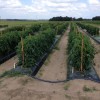 Durante la última década, las frutas, verduras y frutos secos se encuentran entre los alimentos relacionados con brotes de gastroenteritis causadas por cepas enterovirulentas de E. coli y Salmonella no tifoidea que resultan en miles de hospitalizaciones y pérdidas de varios millones de dólares en la industria de alimentos (Mandrell 2009; Batz, Hoffman, y Morris 2011). Desde 2006, dieciséis brotes de salmonelosis se han relacionado con el consumo de frutas y verduras, incluyendo tomates, melones, coles, pepinos, mangos, piñones, pistachos, mantequilla de maní, papayas, pimientos y además alimentos congelados y procesados que contienen productos vegetales. Esta hoja informativa fue producida para proveer información actualizada sobre las prácticas de producción de tomate y sus asociaciones con Salmonella. Esta información es útil para Agentes de Extensión Agraria en sus programas de educación sobre cultivos hortícolas. This 4-page fact sheet is the Spanish language version of The Role of Crop Production Practices and Weather Conditions in Microbiological Safety of Tomatoes and Peppers (SS628). It was written by Massimiliano Marvasi, Max Teplitski, and George Hochmuth, and published by the UF Department of Soil and Water Science, February 2015.
Durante la última década, las frutas, verduras y frutos secos se encuentran entre los alimentos relacionados con brotes de gastroenteritis causadas por cepas enterovirulentas de E. coli y Salmonella no tifoidea que resultan en miles de hospitalizaciones y pérdidas de varios millones de dólares en la industria de alimentos (Mandrell 2009; Batz, Hoffman, y Morris 2011). Desde 2006, dieciséis brotes de salmonelosis se han relacionado con el consumo de frutas y verduras, incluyendo tomates, melones, coles, pepinos, mangos, piñones, pistachos, mantequilla de maní, papayas, pimientos y además alimentos congelados y procesados que contienen productos vegetales. Esta hoja informativa fue producida para proveer información actualizada sobre las prácticas de producción de tomate y sus asociaciones con Salmonella. Esta información es útil para Agentes de Extensión Agraria en sus programas de educación sobre cultivos hortícolas. This 4-page fact sheet is the Spanish language version of The Role of Crop Production Practices and Weather Conditions in Microbiological Safety of Tomatoes and Peppers (SS628). It was written by Massimiliano Marvasi, Max Teplitski, and George Hochmuth, and published by the UF Department of Soil and Water Science, February 2015.
http://edis.ifas.ufl.edu/ss630
Tag: Harvest and Handling of Tomato
Impacto de las variedades de tomate y su estado de madurez en la susceptibilidad a Salmonella
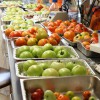 De 1998 a 2007 la fruta fresca, verdura, especias y nueces fueron comúnmente asociados con brotes de gastroenteritis (Batz, Hoffman, y Morris 2011). Salmonella se ha convertido en uno de los patógenos humanos más problemáticos asociado a productos frescos, nueces y a los alimentos que contienen esos ingredientes (Batz, Hoffman, y Morris 2011; deWaal, Tian, y Plunkett 2009). Esta hoja informativa fue producida para proveer información actualizada sobre las prácticas de producción de tomate y sus asociaciones con Salmonella. Esta información es útil para los Agentes de Extensión Agraria en sus programas de educación sobre cultivos hortícolas. This 3-page fact sheet is the Spanish language version of Impact of Tomato Varieties and Maturity State on Susceptibility of Tomatoes to Salmonella (SS627). It was written by Massimiliano Marvasi, Max Teplitski, and George Hochmuth, and published by the UF Department of Soil and Water Science, February 2015. (Photo: Max Teplitski)
De 1998 a 2007 la fruta fresca, verdura, especias y nueces fueron comúnmente asociados con brotes de gastroenteritis (Batz, Hoffman, y Morris 2011). Salmonella se ha convertido en uno de los patógenos humanos más problemáticos asociado a productos frescos, nueces y a los alimentos que contienen esos ingredientes (Batz, Hoffman, y Morris 2011; deWaal, Tian, y Plunkett 2009). Esta hoja informativa fue producida para proveer información actualizada sobre las prácticas de producción de tomate y sus asociaciones con Salmonella. Esta información es útil para los Agentes de Extensión Agraria en sus programas de educación sobre cultivos hortícolas. This 3-page fact sheet is the Spanish language version of Impact of Tomato Varieties and Maturity State on Susceptibility of Tomatoes to Salmonella (SS627). It was written by Massimiliano Marvasi, Max Teplitski, and George Hochmuth, and published by the UF Department of Soil and Water Science, February 2015. (Photo: Max Teplitski)
http://edis.ifas.ufl.edu/ss629
Control of Rapid Postharvest Decays of Tomato Fruit
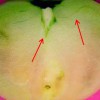 What is a rapid postharvest decay? Water-soaked lesions begin within 12 to 18 hours after harvest and continue to develop, producing large amounts of fluids. The decay spreads within cartons of tomatoes, producing wet patches in the bottom and sides of the container, a condition called “wet-boxes.” Affected fruit are out-of-grade either prior to shipment or upon arrival at the receiver.This 5-page fact sheet was written by J. A. Bartz, S. A. Sargent, and D. J. Huber, and published by the UF Department of Horticultural Sciences, December 2014. (Photo: S. R. Bartz)
What is a rapid postharvest decay? Water-soaked lesions begin within 12 to 18 hours after harvest and continue to develop, producing large amounts of fluids. The decay spreads within cartons of tomatoes, producing wet patches in the bottom and sides of the container, a condition called “wet-boxes.” Affected fruit are out-of-grade either prior to shipment or upon arrival at the receiver.This 5-page fact sheet was written by J. A. Bartz, S. A. Sargent, and D. J. Huber, and published by the UF Department of Horticultural Sciences, December 2014. (Photo: S. R. Bartz)
http://edis.ifas.ufl.edu/hs363
The role of crop production practices and weather conditions in microbiological safety of tomatoes and peppers
 Salmonella and other human pathogens can contaminate produce at any stage from “farm to fork.” If we can better understand how production practices may make crops more or less susceptible to human pathogens we may be able to significantly reduce the number and severity of the produce-associated outbreaks. This 3-page fact sheet provides up-to-date information about tomato production practices and their relationships with Salmonella. Written by Massimiliano Marvasi, George Hochmuth, and Max Teplitski, and published by the UF Department of Soil and Water Science, December 2014. (Photo: Max Teplitski, UF/IFAS)
Salmonella and other human pathogens can contaminate produce at any stage from “farm to fork.” If we can better understand how production practices may make crops more or less susceptible to human pathogens we may be able to significantly reduce the number and severity of the produce-associated outbreaks. This 3-page fact sheet provides up-to-date information about tomato production practices and their relationships with Salmonella. Written by Massimiliano Marvasi, George Hochmuth, and Max Teplitski, and published by the UF Department of Soil and Water Science, December 2014. (Photo: Max Teplitski, UF/IFAS)
http://edis.ifas.ufl.edu/ss628
Impact of Tomato Varieties and Maturity State on Susceptibility of Tomatoes to Salmonella
 Non-typhoidal Salmonella has emerged as one of the problematic human pathogens associated with fresh produce, nuts, and complex foods containing them. Recent research shows that some varieties of plants are more “resistant” to colonization by the pathogens than others. This raises the intriguing possibility that cultivar selection could be used to identify crop varieties that may be less conducive to proliferation of human pathogens. This 3-page fact sheet provides up-to-date information about tomato production practices and their relationships with Salmonella. Written by Massimiliano Marvasi, George Hochmuth, and Max Teplitski, and published by the UF Department of Soil and Water Science, December 2014. (Photo: Max Teplitski, UF/IFAS)
Non-typhoidal Salmonella has emerged as one of the problematic human pathogens associated with fresh produce, nuts, and complex foods containing them. Recent research shows that some varieties of plants are more “resistant” to colonization by the pathogens than others. This raises the intriguing possibility that cultivar selection could be used to identify crop varieties that may be less conducive to proliferation of human pathogens. This 3-page fact sheet provides up-to-date information about tomato production practices and their relationships with Salmonella. Written by Massimiliano Marvasi, George Hochmuth, and Max Teplitski, and published by the UF Department of Soil and Water Science, December 2014. (Photo: Max Teplitski, UF/IFAS)
http://edis.ifas.ufl.edu/ss627
Solutions for Managing Tomato Culls in Florida Tomato Packinghouses (SL371/SS572)
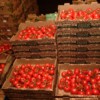 Florida is the single largest producer of fresh-market tomatoes in the United States. Driven by urbanization and generation of large amounts of tomato culls, tomato packers in Florida often struggle to find ways to dispose of culls generated during the cleaning and sanitizing of tomatoes. This 5-page fact sheet provides guidelines for appropriate management practices to increase the use of culls produced in tomato packinghouses in Florida. Written by Gurpal Toor, Maninder Chahal, and Bielinski Santos, and published by the UF Department of Soil and Water Science, September 2012.
Florida is the single largest producer of fresh-market tomatoes in the United States. Driven by urbanization and generation of large amounts of tomato culls, tomato packers in Florida often struggle to find ways to dispose of culls generated during the cleaning and sanitizing of tomatoes. This 5-page fact sheet provides guidelines for appropriate management practices to increase the use of culls produced in tomato packinghouses in Florida. Written by Gurpal Toor, Maninder Chahal, and Bielinski Santos, and published by the UF Department of Soil and Water Science, September 2012.
http://edis.ifas.ufl.edu/ss572
Solutions for Managing Wastewater in Florida Tomato Packinghouses (SL372/SS573)
 A large amount of wastewater is produced in Florida's packinghouses during the cleaning and sanitizing of tomatoes. High transportation costs for off-site disposal and strict surface water discharge regulations are critical issues associated with the management of this wastewater. This 4-page fact sheet provides solutions for increasing the reuse of wastewater in tomato packinghouses in Florida. Written by Gurpal Toor, Maninder Chahal, and Bielinski Santos, and published by the UF Department of Soil and Water Science, August 2012.
A large amount of wastewater is produced in Florida's packinghouses during the cleaning and sanitizing of tomatoes. High transportation costs for off-site disposal and strict surface water discharge regulations are critical issues associated with the management of this wastewater. This 4-page fact sheet provides solutions for increasing the reuse of wastewater in tomato packinghouses in Florida. Written by Gurpal Toor, Maninder Chahal, and Bielinski Santos, and published by the UF Department of Soil and Water Science, August 2012.
http://edis.ifas.ufl.edu/ss573
Postharvest Quality and Decay Incidence among Tomato Fruit as Affected by Weather and Cultural Practices. (PP294)
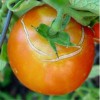 Postharvest decay losses for field-grown, fresh-market tomatoes are usually associated with harvests that occur when fields are wet and warm. During periods of persistently wet fields, decay pathogens infect damaged fruit on the plant as well as injuries to petioles and stems. Review of all reports and photos implicated excessive water in fruit rather than air temperatures as the primary predisposition. Excessive water in fruit is possible at virtually any time of the season and can appear at times of cold as well as warm field temperatures. This 8-page fact sheet was written by Jerry A. Bartz, Steven A. Sargent, and John W. Scott, and published by the UF Department of Plant Pathology, July 2012.
Postharvest decay losses for field-grown, fresh-market tomatoes are usually associated with harvests that occur when fields are wet and warm. During periods of persistently wet fields, decay pathogens infect damaged fruit on the plant as well as injuries to petioles and stems. Review of all reports and photos implicated excessive water in fruit rather than air temperatures as the primary predisposition. Excessive water in fruit is possible at virtually any time of the season and can appear at times of cold as well as warm field temperatures. This 8-page fact sheet was written by Jerry A. Bartz, Steven A. Sargent, and John W. Scott, and published by the UF Department of Plant Pathology, July 2012.
http://edis.ifas.ufl.edu/pp294
Outbreaks of Foodborne Diseases Associated with Tomatoes (FSHN1208/FS192)
 Concerned about the safety of fresh-market tomatoes? This 5-page fact sheet highlights tomato-related outbreaks in the United States and Europe and reviews the locations and venues of tomato preparations as well as the severity of outbreaks. Written by Angela M. Valadez, Keith R. Schneider, and Michelle D. Danyluk, and published by the UF Department of Food Science and Human Nutrition, May 2012.
Concerned about the safety of fresh-market tomatoes? This 5-page fact sheet highlights tomato-related outbreaks in the United States and Europe and reviews the locations and venues of tomato preparations as well as the severity of outbreaks. Written by Angela M. Valadez, Keith R. Schneider, and Michelle D. Danyluk, and published by the UF Department of Food Science and Human Nutrition, May 2012.
http://edis.ifas.ufl.edu/fs192
Growth, Reduction, and Survival of Bacteria on Tomatoes (FSHN1206/FS190)
 Tomato producers are committed to taking proactive steps to ensure and enhance the safety of their fresh-market tomatoes, but even with better food safety controls, the risk for outbreaks of illness associated with tomato consumption still exists. This 32-page fact sheet highlights current tomato safety related studies on the growth, reduction, and survival of bacteria on fresh-market tomatoes. The authors evaluated bacterial studies on natural antimicrobials and detergents, as well as food processing, cross-contamination, and shelf-life studies. Written by Angela M. Valadez, Keith R. Schneider, and Michelle D. Danyluk, and published by the UF Department of Food Science and Human Nutrition, May 2012.
Tomato producers are committed to taking proactive steps to ensure and enhance the safety of their fresh-market tomatoes, but even with better food safety controls, the risk for outbreaks of illness associated with tomato consumption still exists. This 32-page fact sheet highlights current tomato safety related studies on the growth, reduction, and survival of bacteria on fresh-market tomatoes. The authors evaluated bacterial studies on natural antimicrobials and detergents, as well as food processing, cross-contamination, and shelf-life studies. Written by Angela M. Valadez, Keith R. Schneider, and Michelle D. Danyluk, and published by the UF Department of Food Science and Human Nutrition, May 2012.
http://edis.ifas.ufl.edu/fs190